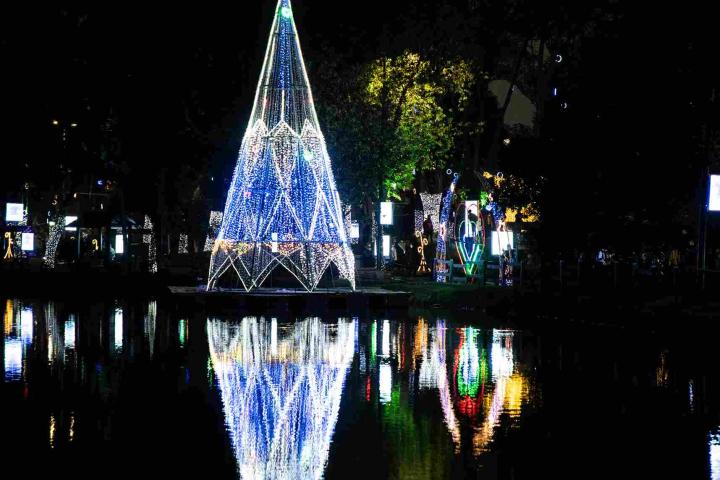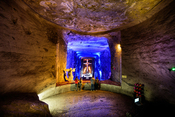Holy Week is the perfect time for the thousands of tourists visiting Bogotá to explore the city's sacred sites. Among the most emblematic are the Sanctuary of Monserrate, located in the eastern hills, and the Sanctuary of the Divine Child Jesus, situated in the 20 de Julio neighborhood in the southern part of the city.
![]()
The churches are considered the city's true architectural and spiritual treasures and are among the nearly 900 Catholic churches in Bogotá. They are also part of the Jubilee of Hope, an event convened by the Vatican for this 2025. This celebration occurs every 25 years and invites the faithful from around the world to engage in a time of spiritual renewal, reconciliation, and connection.
![]()
The recently released Travelers Survey conducted by the Tourism Observatory of Bogotá highlights that Monserrate Hill is one of the top attractions for both national and international tourists visiting the city.
![]()
Among the many temples, Monserrate and the Divine Child stand out, attracting the attention of religious travelers, especially during significant periods like the upcoming Holy Week. Thousands of pilgrims, faithful, and those interested in religious tourism will visit the Fallen Lord of Monserrate and the Divine Child of 20 de Julio. In these sanctuaries, the time of the Christian passion is experienced with special fervor and mysticism. Many seek favors and miracles; some claim their prayers have been answered.
Sanctuary of the Fallen Lord of Monserrate.
Located at an altitude of 3,152 atop one of the eastern hills in the city's center. this temple was originally built between 1650 and 1657 as a tribute by the Recollect Monks of St. Augustine to Our Lady of the Cross of Monserrate. It houses a remarkable sculpture known as the Fallen Lord, which depicts "Santo Cristo Caído a los azotes y clavado en la cruz," a creation of the artist Pedro de Lugo Albarracín. Additionally, it features a replica of the Black Virgin, or Our Lady of Montserrat, which closely resembles the version found in the Monastery of Montserrat in Barcelona, Spain.
![]()
The temple has stood for nearly five centuries and was rebuilt twice due to the earthquakes in 1743 and 1917. Today, it features a neocolonial-style facade, a central body, and two circular towers on each side.
Millions of people have visited one of Bogotá’s most iconic religious sites — an ideal place for seclusion, prayer, and spiritual peace.The Fallen Lord is said to hold many mysteries, one of which is particularly intriguing: as his hair grows, various miracles are believed to happen.
According to data from the Mayor's Office of Bogotá, over 180,000 people visited the Sanctuary of the Fallen Lord of Monserrate during Holy Week in 2025. A similar or even higher turnout is anticipated this year, particularly on Holy Thursday and Good Friday, due to the Eucharist and the ‘Sermon of the Seven Words.’
Monserrate is not all about devotion
At Monserrate, you can enjoy some of the best panoramic views of the city, along with a diverse gastronomic experience. You'll find everything from charcoal-grilled corncobs to fine dining at renowned restaurants like San Isidro and Santa Clara. The latter was recognized as a Tripadvisor Travellers' Choice in 2024, placing it among the top 10% of restaurants worldwide based on diners' preferences and reviews. During your visit, be sure to try the exquisite typical Santa Fe dish—tamal with hot chocolate.
You can purchase Colombian handicrafts and explore the sanctuary. Nature enthusiasts can stroll along various trails, starting from Monserrate Hill.
![]()
How to get there?
The Monserrate Sanctuary is located at Carrera 2a Este #21-48 in the Bosque Izquierdo neighborhood and offers several ways to access it. The first option is for most visitors who choose to ascend on foot along the 2.5-kilometer pedestrian path. Along the way, there are two viewpoints that offer stunning views. The second option is to take the funicular or cable car, with ticket prices ranging from COP 20,000 to COP 90,000.
More information about the masses time, prices and access at https://monserrate.co/en/
Sanctuary of the Divine Child 20 de Julio
![]()
The origins of this temple date back to the 1930s, thanks to the Salesian priest Juan del Rizzo. He brought a modified image of the Divine Child of Prague to the then-remote region south of Bogotá. This image was notable for lacking the cross and featuring a face inspired by one of the artist's sons. Since its establishment, the sanctuary has seen significant growth in its architectural developments and the number of parishioners. Thousands of visitors come here with seclusion and faith to express gratitude and to ask for help with their needs.
![]()
The Sanctuary of the Divine Child, located in the neighborhood that shares its name, was inaugurated in 1942 as a tribute to Colombia's Independence Day. Over the years, it has become a center of Catholic devotion, with many believers attributing miracles to the image displayed on the church's altar. This veneration has gained national significance. As the number of pilgrims visiting to honor this miraculous image has increased, the church now holds up to 20 masses every Sunday, attended by around 70,000 parishioners. According to data from the Local Mayor's Office of San Cristóbal, approximately 112,000 people visited the sanctuary during Holy Week in 2024.
A large influx of devotees and visitors is anticipated for the upcoming Holy Week, particularly on Palm Sunday (April 13), as well as during the Eucharist and sermons on Holy Thursday and Good Friday.
The church was designed by architects Giovanni Buscaglione and Constantino de Castro. Its layout includes a small square, a central altar, and four chapels. The main altar features a marble statue of the Risen Christ, while the image of the Divine Infant Jesus, protected by a crystal urn, is displayed in a prayer room.
![]()
How to get there?
It is located at Calle 27 Sur #7-50, in the San Cristóbal locality. You can take a TransMilenio bus to 20 de Julio Station, which is very close to the sanctuary. The neighborhood has 56 SITP stops, offering a variety of routes available at all times. It is recommended to avoid arriving by private vehicle, especially on Sundays, to prevent long lines and limited access to nearby parking lots. In the area, you can buy images, religious items, and souvenirs featuring the Divine Child Jesus of 20 de Julio.
![]()











